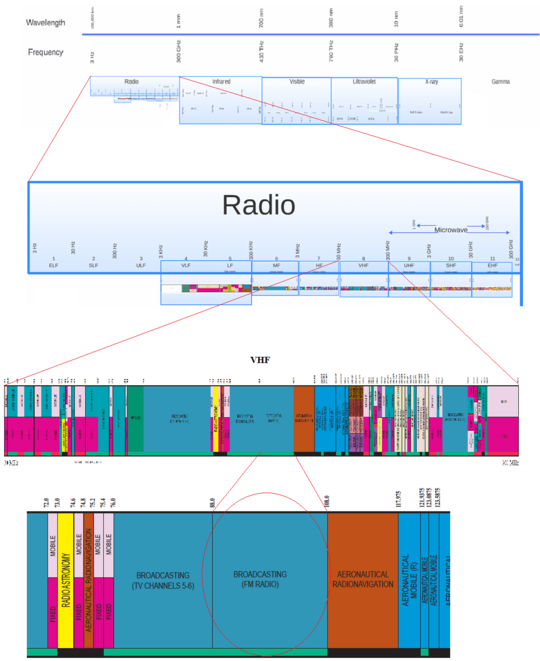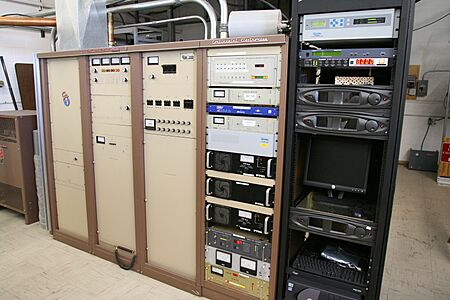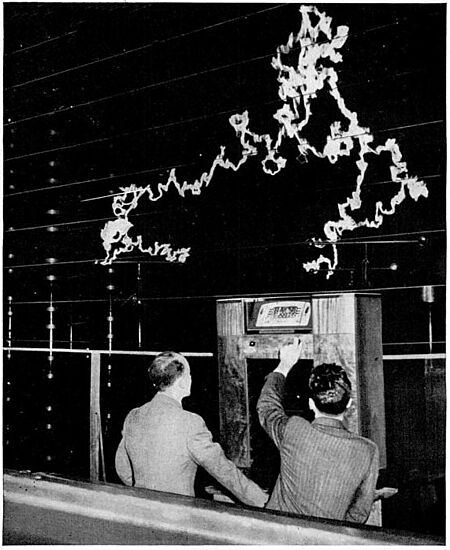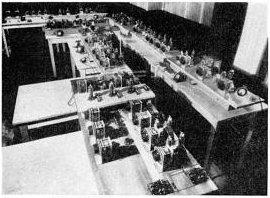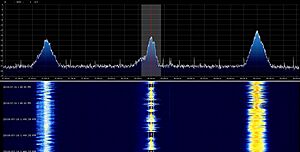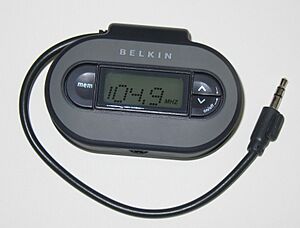FM broadcasting facts for kids
FM broadcasting is a popular way to send sound over the radio. It uses something called frequency modulation (FM). This means the radio wave's frequency (how fast it wiggles) changes to carry the sound.
An American engineer named Edwin Armstrong invented this method in 1933. Today, FM radio is used all over the world. It's known for its clear, high-quality sound. FM radio sounds much better than older methods like AM broadcasting. It also has less static and crackling noises. That's why most music and general audio programs are broadcast on FM. FM radio stations use a special range of radio frequencies called very high frequency (VHF).
Contents
Where Does FM Radio Broadcast?
FM radio stations broadcast in a specific part of the radio spectrum called the VHF band. Most countries use the range from 87.5 to 108.0 MHz.
There are a few exceptions:
- In some former Soviet countries, an older band from 65.8–74 MHz is still used.
- In Japan, the band 76–95 MHz is used for FM radio.
- In Brazil, the FM band recently expanded to include 76-88 MHz. This helps older AM radio stations move to FM.
The frequency of an FM station is usually a multiple of 100 kHz. For example, you might hear stations at 98.1 MHz or 105.7 MHz. In some places like the Americas, only odd multiples are used. In parts of Europe, only even multiples are common. In the United Kingdom, both are used. To avoid stations interfering with each other, they usually keep at least 500 kHz apart if they are in the same area.
How FM Technology Works
How Sound Becomes a Radio Wave
Frequency modulation (FM) is a way to put information onto a radio wave. Imagine a steady radio wave, called a carrier wave. With FM, the sound you want to send changes how fast this carrier wave wiggles (its frequency). The louder the sound, the more the frequency changes from its normal spot.
This is different from amplitude modulation (AM), where the sound changes the height (amplitude) of the wave, but its frequency stays the same. FM signals use more "space" (bandwidth) on the radio spectrum. That's why FM is often used for higher frequencies like those for TV and mobile radios.
Each country has rules about how much an FM carrier wave's frequency can change. For stereo radio, the maximum change is usually ±75 kHz. For mono (single channel) radio, it's also often ±75 kHz, though some countries use a smaller change like ±50 kHz.
Making Sound Clearer: Pre-emphasis and De-emphasis
When you listen to FM radio, you might notice that high-pitched sounds and noise can be a problem. To make the sound clearer, FM systems use a trick called pre-emphasis and de-emphasis.
Before the sound is sent out, the high-pitched parts are made a bit louder (pre-emphasis). Then, when your radio receives the signal, it makes those high-pitched parts quieter again (de-emphasis). This also makes the high-pitched noise quieter, so you hear less hiss.
Most of the world uses a 50 microsecond setting for this. In the Americas and South Korea, a 75 microsecond setting is used.
How Stereo FM Works
For a long time, people wanted to send stereo sound (sound with left and right channels) over FM radio. In 1961, two systems, from General Electric and Zenith, were approved in the United States. Most other countries adopted this same method.
To make sure stereo broadcasts still work on older mono radios, a clever trick is used:
- The left (L) and right (R) sound channels are combined into two signals: an (L+R) signal and an (L−R) signal.
- A mono radio only uses the (L+R) signal, so you hear both channels through one speaker.
- A stereo radio uses both signals. It adds (L+R) and (L−R) to get the left channel. It subtracts (L−R) from (L+R) to get the right channel.
A special 19 kHz "pilot tone" is also sent. This tone helps your stereo radio know it's a stereo broadcast and correctly separate the left and right sounds.
When you listen to stereo FM, the signal might have more noise or distortion than mono FM, especially if the signal is weak. Many car radios will automatically switch to mono sound if the signal gets too weak, even if they still show it's a stereo broadcast.
Other Services on FM Radio
FM broadcasting can also carry other information using "subcarriers." These are extra signals hidden within the main broadcast. This has been popular in the US for a long time.
Some uses for these extra signals include:
- Radio reading services: These read newspapers or books for people who are blind.
- Private data services: For example, sending stock market information to businesses.
- Background music services: Providing music for shops without commercials.
- Paging services: Like old-fashioned "beepers."
A common digital service is the Radio Data System (RDS). This uses a 57 kHz subcarrier. It sends small bits of digital information like:
- The station name (e.g., "Z100").
- Alternative frequencies (AF) to help your radio find the best signal.
- Traffic information for navigation systems.
- Radio text (RT), which can show song titles or other messages.
In the United States and Canada, a digital radio service called HD Radio is used. It sends both the normal analog FM signal and a digital signal at the same time. This allows for clearer sound and extra channels.
How Far Can an FM Signal Go?
The power of an FM transmitter helps determine how far a radio signal will travel. Other important factors are how high the antenna is and how well it focuses the signal. Transmitters can range from very small (a few milliwatts) to very powerful (80 kW). Powerful transmitters are expensive to run and are usually only used by large stations.
A Brief History of FM Radio
FM Radio in the Americas
Brazil
The first FM radio station in Brazil was Rádio Imprensa, which started broadcasting in Rio de Janeiro in 1955. At first, not many people had FM radios, so the station mainly played background music for businesses. In the 1970s, FM radio became much more popular in Brazil, and AM radio slowly became less common. Recently, Brazil expanded its FM band to help more AM stations switch to FM.
United States
FM broadcasting began in the United States in the late 1930s with a few experimental stations. Edwin Armstrong himself owned one of the first, W2XMN, in New Jersey. These early stations often played classical music or educational programs.
In 1945, the FCC (the government agency that manages radio) moved the FM band to a new range (88–108 MHz). This made all the older FM radios useless and slowed down FM's growth. However, by the late 1960s, FM became popular for rock music. By 1978, more people were listening to FM than AM in North America. Today, AM radio is mostly used for talk shows, news, sports, and religious programs, while FM is where most music is found.
FM Radio in Europe
In Western Europe, the medium wave (AM) band was very crowded after World War II. This caused a lot of interference. Countries like Germany quickly adopted FM radio because they needed more clear channels.
United Kingdom
The BBC in the United Kingdom started FM broadcasting in 1955 with three national networks. Over time, more commercial stations began using FM. By the 1980s and 1990s, FM became the main way people listened to radio in the UK.
Italy
Italy quickly adopted FM broadcasting in the early 1970s. This happened after a court decision allowed "free radio" stations to broadcast. Soon, every city in Italy had many private FM radio stations.
Greece
In Greece, "pirate" FM radio stations started broadcasting in the mid-1970s, even before national stations did. By the end of the 1970s, most of Greece was covered by national FM programs, and many cities had their own "pirate" stations. Private commercial FM radio stations were allowed much later, in 1987.
FM Radio in Australia and New Zealand
Both Australia and New Zealand adopted FM radio later than many other countries. In Australia, early experimental FM broadcasts were even shut down for a while. FM broadcasting finally reopened in 1975 and grew steadily. Today, most urban radio in Australia is on FM.
In New Zealand, it took "pirate" broadcasters to convince the government to allow FM. The first commercial FM licenses were approved in 1983. Many cars imported from Japan have radios that only work on a different FM band (76-90 MHz), so people often need special devices to listen to New Zealand's 88-108 MHz stations.
The Future of FM Radio
Some countries are starting to switch from FM radio to Digital audio broadcasting (DAB+). In 2017, Norway became the first country to completely switch to DAB+, though some local FM stations remained for a few more years. This change means that people, especially in rural areas, can get many more radio stations than before.
Small FM Transmitters for Everyday Use
Using Small FM Transmitters at Home
You can buy small FM transmitters that let you send music from your phone or MP3 player to a regular FM radio. These are often used in cars that don't have an auxiliary input. Some people even use them to play music for holiday light shows! These devices are legal in many countries, including the US and most of Europe.
Small FM transmitters are also used in some inexpensive wireless microphones, especially for karaoke toys. This lets you use an FM radio as your speaker.
Some wireless headphones also use the FM broadcast band. However, higher-quality headphones usually use other wireless technologies for better sound.
Helping People Hear: Assistive Listening
Some devices that help people with hearing difficulties use FM radio. They often use a special band of frequencies (72.1 to 75.8 MHz) that most regular FM radios can't tune into.
Neighborhood Radio Stations
Small, low-power FM transmitters are sometimes used for local neighborhood or school radio stations. These are called "microbroadcasting." They don't usually reach as far as AM microbroadcasters because of how FM signals work.
Secret Uses of FM Transmitters
Small FM transmitters have also been used as "bugs" for espionage or surveillance. The advantage is that the receiving equipment (a regular FM radio) wouldn't look suspicious. These "bugs" are often tuned to frequencies just outside the normal FM band, which many older radios can still pick up.
Building a "bug" is a common project for electronics hobbyists. Also, many pirate radio stations broadcast on the FM band because it offers clearer sound and more listeners.
See also
- FM broadcasting in Australia
- FM broadcasting in Canada
- FM broadcasting in Japan
- FM broadcasting in New Zealand
- FM broadcasting in the UK
- FM broadcasting in the United States
- RDS (Radio Data System)



